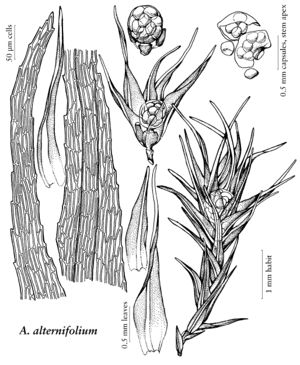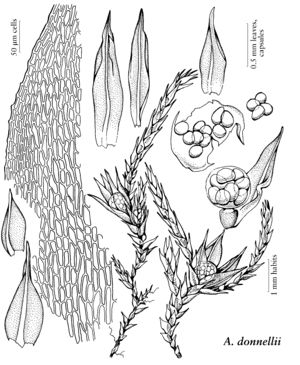Archidiaceae
Plants small to minute, perennial or ephemeral, sometimes with a persistent pale gray, green or red-brown thallose protonemal cushion attached to rhizoids. Stems simple or branched, erect or sometimes prostrate, sterile innovations usually produced from axils of distal stem leaves or perichaetial leaves, becoming prostrate, stoloniferous and persistent, giving rise to new shoots. Leaves of distal portions of stem and perichaetia erect to spreading; base somewhat clasping; costa in cross section with undifferentiated incrassate cells, or sometimes thin-walled larger cells above and below central incrassate cells; laminal areolation uniform to somewhat differentiated, cells elongate, mostly rectangular to rhomboidal, alar cells often differentiated, somewhat hyaline, limbidium of differentiated cells absent. Specialized asexual reproduction rarely present as filiform uniseriate rhizoidal tubers. Sexual condition monoicous. Seta none. Capsule terminal or lateral, sessile, globose, 200–1000 µm, apiculatus absent, cleistocarpous. Calyptra ephemeral, falling away as capsule matures, occasionally present as a thin membrane at apex. Spores 50–320 µm in longest diameter, rarely much larger, 4–176 per capsule.
Distribution
Worldwide except Antarctica, in subtropical to warm-temperate regions.
Discussion
Genus 1, ca. 35 species (6 in the flora).
Archidiaceae is most diverse in Africa and Australia. It is highly unusual in its sporophyte ontogeny, as the endothecium does not differentiate into a columella and an archesporial layer. The spores are massive, and can develop from any cell in the endothecium. No operculum or peristome is present (capsules are cleistocarpous) and the spores are liberated by the breakdown or tearing of the capsule wall. The family is usually placed in its own order as the Archidiales.


